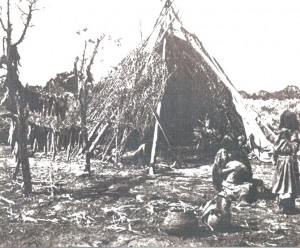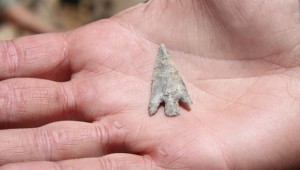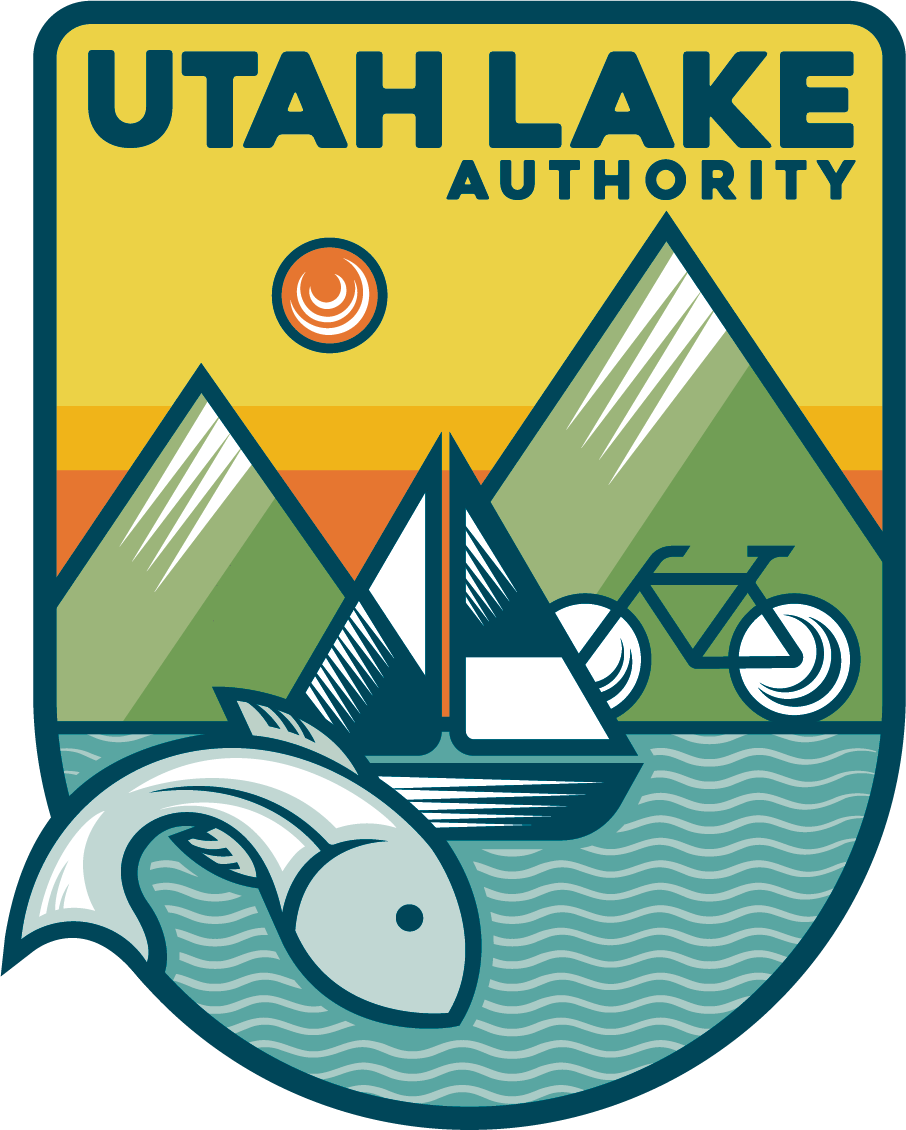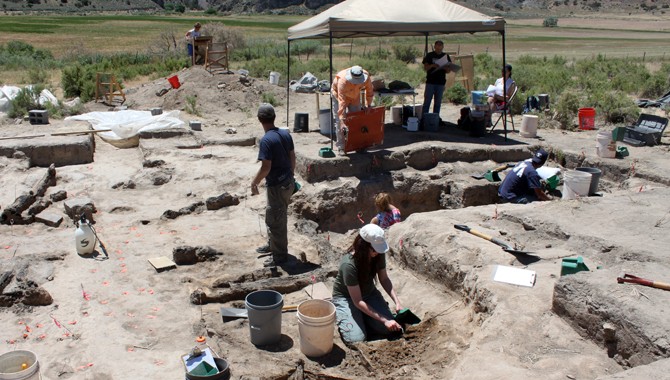The fascination of ancient archeological digs is not only found in Egypt and the Middle East, but can also be found in our own backyard. A priceless resource, Utah Lake was home to many prehistoric residents and provided a living for them. These primitive cultures left their “historical footprints” in small mounds located all around the Lake. This educational inheritance is valuable to the modern world because of the snapshot they shared through their remaining objects and artifacts.
Utah Lake was used by many Native American groups before the arrival of Father Escalante, Lewis and Clark, mountain men such as Jim Bridger, Jeremiah Johnson, and or even before the Mormon pioneers settled here. To understand the full impact the freshwater lake has had on so many inhabitants for countless generations, we need to evaluate and reconstruct the lifestyle of various people who lived there. The documented cultures are Paleo-Indians, Archaic, and Fremont with the more recent tribes of Ute, Paiute, and Shoshone. (See fourth grade curriculum). As we learn from these past populations, we can study the present to create a positive future path for Utah Lake.
Larry J. Zimmerman, PhD, a recipient of the World of Archaeological Congress Award for his support of the Native Repatriation Act, has said, “Archaeology is the scientific study of peoples of the past … their culture and their relationship with their environment. The purpose of archaeology is to understand how humans in the past interacted with their environment and to preserve this history for present and future learning.”
Each spring semester beginning in April, professors and students conduct archeological research throughout Utah. For the past several years, these archeological digs have been taking place around Utah Lake. Professor Joel Janetski initially started the digs, but he has retired from his position at Brigham Young University. Since Janetski’s retirement, Professor James Allison has assumed the lead role and has headed the students’ research.
Professor Allison has noted other renowned archaeologists and anthropologists have previously researched Utah Valley and Utah Lake.
- 1872 – A government expedition under direction of Lt. George M. Wheeler (called “Wheeler Expedition”) researched Utah and surrounding areas for past cultures, etymology, ornithology, and other subjects. This expedition was photographed. The results were written up in a report to the government.
- John Hutchings’ findings resulted in the Hutchings Museum of Lehi, Utah.
- James and Robert Bee (father and son) found over 100 archaeological sites in west Provo.
- BYU’s first Archaeologist was Albert Reagan, who worked at BYU for two years and with the Bureau of Indian Affairs.
- 1877 – Naturalist Edward Palmer excavated two mounds in Payson and found artifacts including weapons. These collections were donated to the Peabody Museum at Harvard.
- 1930s – Julian Steward, famous anthropologist from the University of Utah, established a program for Utah archaeology.
- Between the 1940s and 1960s, BYU has a history of researching various sites in Utah Valley.
- 1980 – Dr. Joel Janetski, on the southwest edge of Utah Lake in Mosida, a 4000 year old burial was found.
- 1980 – 2009 – Professor Janetski worked at other significant places such as Heron Springs and sandy beach sites which are both late Prehistoric sites (dating to the 1400s and/or 1500s along the northern shore of Utah Lake. He dug at Goshen Island site on the edge of Goshen Bay, which had two occupations, one a little more than 2000 years ago and another in the late prehistoric period. He also worked at American Fork cave, which previously had been excavated in 1938 and was a big horn sheep hunting cap dating back about 3000 years ago. He also researched the Fox site, which dated to the 1600s and was in the Jordan River narrows. These were all hunter-gatherer sites that predate the Fremont farmers. Mr. Janetski also worked at a notable Fremont site called Kay’s Cabin at Kimball Creek, south of Goshen and Wolf Village.
- 2009 – 2012 – In 2009, Dr. Joel Janetski began research at Wolf Hollow. Dr. James Allison took over leadership and worked with BYU students at the site, near south Goshen Bay of Utah Lake.
Since 2009, BYU’s dig, named Wolf Village, has been located near Currant Creek, south of Goshen, Utah. Finding different bits and pieces, they have gained insight into the way of life of the various civilizations that lived around Utah Lake. While slowly sifting through the dirt at the Goshen Bay site, they have found pit structures that are about 1000 years old. The best interpretation from radiocarbon dating is the structures were built about A.D. 1025-1050. Several remnants of adobe houses were found with extensive objects. Wolf Village is determined to have belonged to the Fremont Indians. There is other known Fremont evidence located in west Provo, South Goshen Bay, and many others.

At Wolf Village, findings include ceramics, pottery pieces, excavations of buildings/structures, and food remains such as beans, corn, and animal bones. They have found turquoise, projectile points (arrow heads and spear points), and instruments for grinding maize and seeds as well as cooking utensils. These discoveries show that the Fremont Indians were farmers, hunters, and gatherers. Shells (from the Pacific Ocean) were found providing evidence of the Fremont Indians trading networks extending as far as the west coast. These have resulted in the cultures being known as farmers, hunters, and gatherers and interaction or trading with other tribes from the west coast. Each object found is documented, identified, categorized, and discussed on how they relate to the goal of studying the Fremont Indians.
Professor Allison explained the Fremont culture left two types of rock art. Petroglyphs are “pecked” into the walls of the rocks and pictographs are objects painted on the walls. These have been found in West Mountain and Lake Mountain area near Utah Lake.

The federal government is focusing on preservation of this rich heritage and recognizing its value. They have established and enabled the Antiquities Act on Federal Land, the Natural Historical Preservation Act of 1966, and another law called Archaeological Resource Protection Act in 1979. These laws have been amended as needed. Utah has also established state laws to protect archaeological sites with their historical records on state lands.
“It is important to preserve these locations,” said Professor Allison. “We need to be aware of the artifacts, and learn from people who lived in the same place and environment that we do.” In their research, the students want to have the answers to the secrets revealed. They are hoping to find answers to their questions of why the Fremont Indians left; did they revert to a hunter-gatherer economy; or were they replaced with other hunter-gatherers? This archaeological mystery is one they want to resolve with the clues they found.
After the excavation is complete, the digs are carefully filled in to preserve the integrity of the site, as well as to prevent others from vandalizing the area, or weather and erosion from destroying it.
Background:
- Professor James Allison holds a PhD in Anthropology from Arizona State University. He attained his Bachelor’s and Master’s from BYU in Archaeology, working in Arizona, southern and central Utah, Colorado, Nevada, and more recently with BYU students in studying Utah Valley.
- Professor Joel Janetski has written a lot about Utah Valley archaeology, including articles for the Utah Historical Quarterly. In a 1990 article, he describes some of his studies and work. Recently (2009), he published a volume on the hunter-gatherer archaeology of Utah Valley.
This is the first of articles to feature the history and archaeological benefits found around Utah Lake and various dig sites. Watch for future information.


I would love to volunteer. How does one volunteer or join the group?
You would need to contact Dr. Allison to see if he is still doing any work near the lake. https://anthropology.byu.edu/Pages/Faculty/JamesAllison.aspx
Thanks Luke! How would I contact Dr. Allison?
You can find his contact info by following this link: https://anthropology.byu.edu/Pages/Faculty/JamesAllison.aspx
I found a perfectly preserved artifact of a ancient Indian or Egyptian while fishing the lower Provo river
I don’t know if its ancient or a replica I’ve had it for a couple years now. I found it in a small cave the river washed open. It has perfect handmade design. Probably nothing but you never know
ALL of the thousands of rocks in my Tooele back yard have been carved into owls, baby owls and rattle snakes. Usually all three on the same rock. Who did this and why?
Have you found them anywhere else that is in close proximity?
John,
Send me a picture of the rocks and I can ask an expert who might be familiar with their origins.
eric@utahlakecommission.org
Is it possible to have any proof or location of petroglyphs on West Mountain? I am hoping to become involved in preserving them if they indeed exists …
Thank you
We correspond regularly with Kari Nelson, from BYU’s Museum of People and Cultures. We’d recommend you get in touch with her. You can reach her by email at mpc_programs@byu.edu or via phone at 801-422-0022. Just tell her Sam Braegger from the Utah Lake Commission reffered you to her. Good luck!
Are you aware of the loss of rockart on both Lake Mtn. and West Mountain from shooting and mining operations?
The BLM did a Environmental Assessment two years ago and determined that shooting needed to stop so the rockart would not be destroyed. BLM has not acted on implementation of the amendment.
Thanks for the comment, Steven!
One of the major concentrations of rock art has been protected through an easement. We are excited to hear that the county is in the process of developing a shooting range that would attract casual target shooters away from the historical sites and into a more appropriate location.